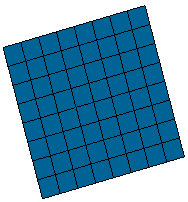This test lets you check analysis results for a simply-supported thin square plate, in the context of an harmonic dynamic response case. You will use 2D meshes.
This test proposed by NAFEMS is used to validate the following attributes:
-
2D shell elements (i.e. the elementary stiffness and mass matrices)
-
Harmonic dynamic response solve algorithms.
Reference:
NAFEMS-Glasgow, Benchmark newsletter, Report No. E1261/R002, p.21, February 1989.
 Specifications
Specifications
Geometry Specifications
|
Length: |
|
|
Thickness: |
Analysis Specifications
|
Young Modulus (material) |
|
|
Poisson's Ratio (material) |
|
|
Density: |
|
|
Restraints (User-defined): Tx = Ty = Rz = 0
at all nodes |
|
|
|
 Results
Results
The results for different finite elements are presented in the table below.
The peak is the value at undamped natural frequency.
In this particular test, the undamped natural frequency is 2.377 Hz.
|
Type of values |
Reference solution |
Values |
|||||||
|
Linear triangle shell |
Parabolic triangle shell |
Linear quadrangle shell |
Parabolic quadrangle shell |
||||||
|
|
|
|
|
||||||
|
Computed Results |
Error [%] |
Computed Results |
Error [%] |
Computed Results |
Error [%] |
Computed Results |
Error [%] |
||
|
Peak displacement [mm] |
45.420 |
45.430 |
0.023 |
45.430 |
0.022 |
45.477 |
0.125 |
45.429 |
0.020 |
|
Peak stress [MPa] |
30.030 |
32.005 |
6.58 |
32.082 |
6.83 |
31.976 |
6.48 |
32.227 |
7.32 |
To Perform the Test:
The Harmonic_forced_vibration_of_a_simply_supported_thin_square_plate.CATAnalysis document presents a complete analysis of this case, computed with a mesh formed of linear quadrangle elements (QD4).
To compute the case with parabolic quadrangle (QD8), linear triangle (TR3) and parabolic triangle (TR6) elements, proceed as follow:
-
Open the CATAnalysis document.
-
In the Advanced Meshing Tools workbench, replace the mesh specifications as indicated above.
-
In the Generative Structural Analysis workbench, compute the case.

